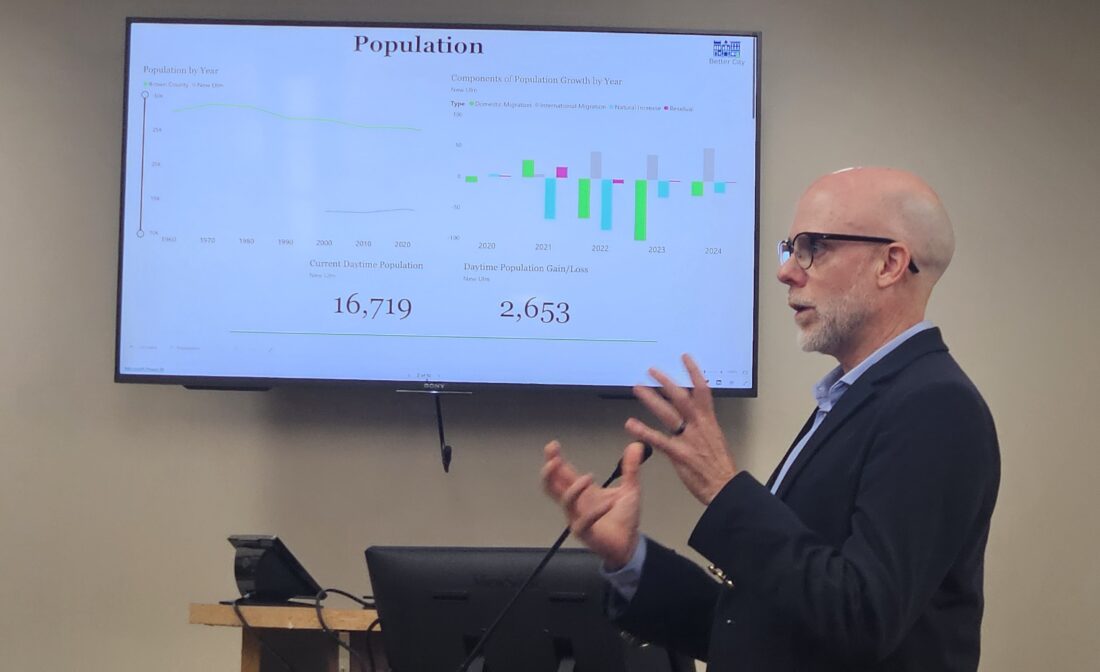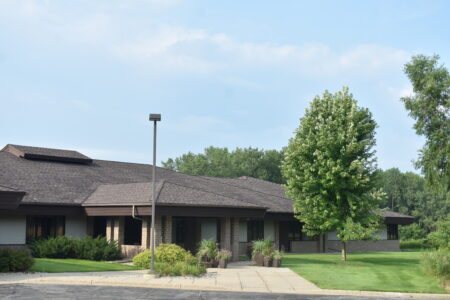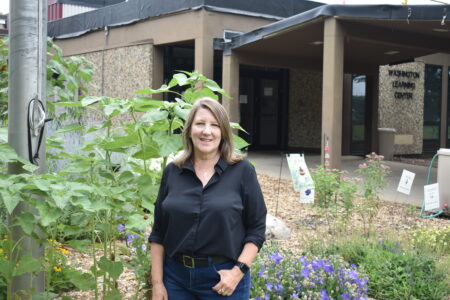‘How can we be better?’
New Ulm EDA discusses strategic planning for housing, workforce and day careNew Ulm EDA discusses strategic planning for housing, workforce and day care

Better City CEO, Jason Godfrey leads a New Ulm Economic Development Authority (EDA) discussion on strategic planning during a special EDA work session. The discussion cover everything from housing, workforce, day care and New Ulm population trends.
NEW ULM — The New Ulm Economic Development Authority (EDA) dug into issuing housing, workforce, day care and population trends Tuesday during a special work session.
The EDA recently contracted with Better City to help develop a strategic plan for economic development. As part of the planning Better City CEO Jason Godfrey led the board in a discussion to determine what direction the EDA needed to move.
The discussion started with data analytics Better City had collected from the community. The first piece of data was related to population and the workforce. In New Ulm, between 4,000 and 5,000 people travel to New Ulm every day for work but live in another community. Only 2,200 leave New Ulm for work but continued to live in the city.
“They could be grocery shopping, going to a restaurant, or buying their clothes here,” EDA board member Reinhart-Kalk said. “That’s a lot of people who could be spending money here. That’s a good tax base money.”
EDA member and New Ulm Council president Andrea Boettger said that those commuting to New Ulm for work were doing so because of better paying jobs than they were finding in their home communities. It suggested there was a way to grow the population if housing were available.
Better City provided data on New Ulm’s current housing, which continues to be rated a priority for the community, but Godfrey challenged this narrative with the data pointing out that the number of houses per capita has increased in the last decade. In addition, New Ulm had greater home affordability that the majority of the country. He said there was a big dip in affordability in 2021. The median price of homes was increasing faster than incomes, but prices were stabilizing.
Godfrey also pointed to the multiple housing projects in the works across New Ulm including two projects on Highland Avenue and the George Ballroom Development. He asked the EDA board if housing will still be a need within the next couple years.
EDA Chairwoman Michelle Markgraf said, based on the numbers, her concern was that New Ulm might not have enough jobs to bring people to town.
Reinhart-Kalk said she wanted to see more manufacturing and jobs in the community, but she worried the city could not fill manufacturing positions without the housing in place first.
The next question: where did the next wave of housing come from? Godfrey asked if the city created a new development or tried to revitalize downtown?
Boettger said she wanted to revitalize downtown because that is where most people are already gathering.
Godfrey said in his tour of downtown his noticed many second floors that appeared vacant, he asked why renovation had not happened.
Reinhart-Kalk said the cost to improve would be astronomical.
Boettger said many would need elevators and that’s cost-prohibitive.
Board member Lindsay Henn said even a sprinkler system would cost more than could be gained from renters.
Godfrey said one the most interesting data figures he found for New Ulm was the statistics for non-employer business verses employer business.
Overall, the number of new businesses in New Ulm was increasing, but overall employment numbers were decreasing. During COVID, may people, new entrepreneurs started their own businesses, but these were single employee businesses that did not scale up. No new jobs were created because of the businesses.
At the same time, the larger employers had people retiring without being replaced. Increased automation was able to fill in for the lost position.
Godfrey warned this trend was not over. The large employers were not likely to hire more people.
Throughout the discussion, Godfrey emphasize that not all businesses were created equal. Businesses that grow the workforce or expand the business ecosystem were the most valuable. In addition, the city needs to look for a business that will not cannibalize other business. As an example, he said there was a limited market in the industry for salons and barbershops. Every new business that cuts hair is cutting into the same business.
“We want something that grows the pie,” he said.
He asked the EDA to think strategically when provided support for a new business.
“What is the public benefit?” Godfrey asked. “Why spend money public money to train a business. Why does a taxpayer care if a new entrepreneur is trained?”
He said the taxpayer will care if that entrepreneur is bringing new jobs to the community.
Godfrey also challenged the EDA on the need for more day cares. A top priority for the EDA and the city as a whole was fighting a childcare shortage, but based on workforce participation, Godfrey was not certain there was a shortage.
New Ulm’s workforce participation was 84.4% — meaning the majority of people able to work were doing so.
“We’ve never seen a metric this high,” Godfrey said. “84.4% is unheard of.” Most communities had around 70% participation and many of those with child care shortages had even lower workforce participation because parents were staying home with kids. New Ulm’s high percentage suggested few parents were staying home.
Boettger pushed back against that. She said there were too many stories of people who were struggling to find a day care spots for a newborn. She knew of young families who chose not to move to New Ulm because of the low access.
“It is a thing here,” she said. “If you get pregnant you call every day care on the list and hope someone has a space for you.”
EDA coordinator Heather Bregel said the issue was with children under 2 years. Parents could find day care for older kids, but it was the young families that struggled. She said some people start looking for childcare spots before they are even pregnant.
There were also some parents choose to work different shifts to ensure one could always watch the kids, but was not ideal for family life.
Henn said she knew of parents who worked remotely to watch their children.
Godfrey suggested New Ulm workers were finding a workaround for the day care crisis, but would welcome additional assistance.
At the close of the strategic planning discussion, Godfrey asked the board to think of what does ideal look like for an economic environment in New Ulm.
He said New Ulm was a beautiful city that was less distressed than many of the communities visited by Better City. He believed the city had an infrastructure and vitality greater than city’s twice its size.
“The goal is always what is next, how can we be better,” Godrey said.





